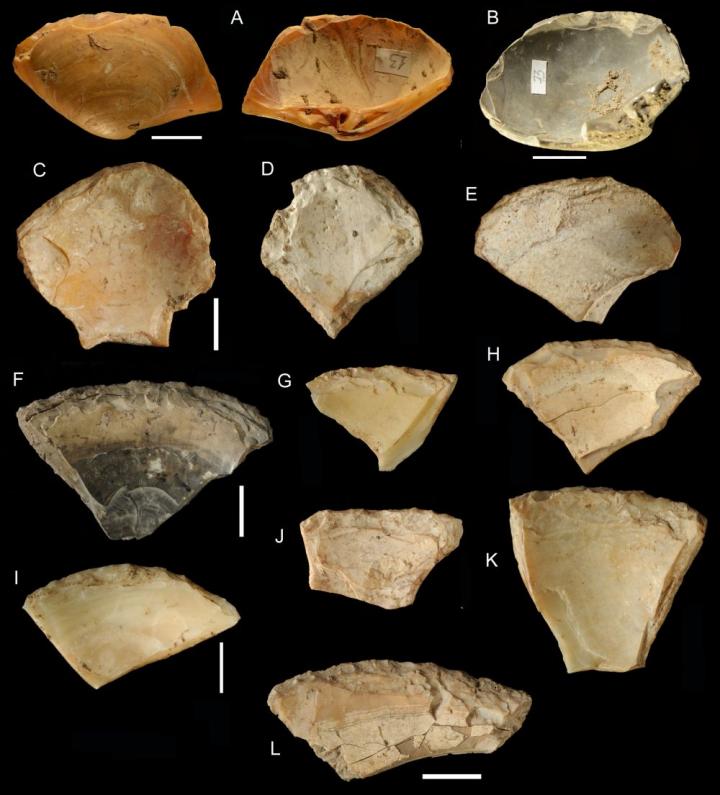Neandertals went underwater for their tools
Neandertals collected clam shells and pumice from coastal waters to use as tools

Neandertals collected clam shells and volcanic rock from the beach and coastal waters of Italy during the Middle Paleolithic, according to a study published January 15, 2020 in the open-access journal PLOS ONE by Paola Villa of the University of Colorado and colleagues.
Neandertals are known to have used tools, but the extent to which they were able to exploit coastal resources has been questioned. In this study, Villa and colleagues explored artifacts from the Neandertal archaeological cave site of Grotta dei Moscerini in Italy, one of two Neandertal sites in the country with an abundance of hand-modified clam shells, dating back to around 100,000 years ago.
The authors examined 171 modified shells, most of which had be retouched to be used as scrapers. All of these shells belonged to the Mediterranean smooth clam species Callista chione. Based on the state of preservation of the shells, including shell damage and encrustation on the shells by marine organisms, the authors inferred that nearly a quarter of the shells had been collected underwater from the sea floor, as live animals, as opposed to being washed up on the beach. In the same cave sediments, the authors also found abundant pumice stones likely used as abrading tools, which apparently drifted via sea currents from erupting volcanoes in the Gulf of Naples (70km south) onto the Moscerini beach, where they were collected by Neandertals.
These findings join a growing list of evidence that Neandertals in Western Europe were in the practice of wading or diving into coastal waters to collect resources long before Homo sapiens brought these habits to the region. The authors also note that shell tools were abundant in sediment layers that had few stone tools, suggesting Neandertals might have turned to making shell tools during times where more typical stone materials were scarce (though it’s also possible that clam shells were used because they have a thin and sharp cutting edge, which can be maintained through re-sharpening, unlike flint tools).
The authors add: “The cave opens on a beach. It has a large assemblage of 171 tools made on shells collected on the beach or gathered directly from the sea floor as live animals by skin diving Neandertals. Skin diving for shells or fresh water fishing in low waters was a common activity of Neandertals, according to data from other sites and from an anatomical study published by E. Trinkaus. Neandertals also collected pumices erupted from volcanoes in the gulf of Naples and transported by sea to the beach.”
###
Citation: Villa P, Soriano S, Pollarolo L, Smriglio C, Gaeta M, D’Orazio M, et al. (2020) Neandertals on the beach: Use of marine resources at Grotta dei Moscerini (Latium, Italy). PLoS ONE 15(1): e0226690. https:/
Funding: National Science Foundation Grant 1118143, BCS Archaeology, to PV (PI) and SS (co-PI). The funders had no role in study design, data collection and analysis, decision to publish, or preparation of the manuscript.
Competing Interests: The authors have declared that no competing interests exist.
Press release from the Public Library of Science
Beach-combing Neanderthals dove for shells
Did Neanderthals wear swimsuits? Probably not. But a new study suggests that some of these ancient humans might have spent a lot of time at the beach. They may even have dived into the cool waters of the Mediterranean Sea to gather clam shells.
The findings come from Grotta dei Moscerini, a picturesque cave that sits just 10 feet above a beach in what is today the Latium region of central Italy.
In 1949, archaeologists working at the site dug up some unusual artifacts: dozens of seashells that Neanderthals had picked up, then shaped into sharp tools roughly 90,000 years ago.
Now, a team led by Paola Villa of the University of Colorado Boulder has uncovered new secrets from those decades-old discoveries. In research published today (editor’s note: January 15) in the journal PLOS ONE, she and her colleagues report that the Neanderthals didn’t just collect shells that were lying out on the beach. They may have actually held their breath and went diving for the perfect shells to meet their needs.
Villa, an adjoint curator in the CU Museum of Natural History, said the results show that Neanderthals may have had a much closer connection to the sea than many scientists thought.
“The fact they were exploiting marine resources was something that was known,” Villa said. “But until recently, no one really paid much attention to it.”
Cave discoveries
When archaeologists first found shell tools in Grotta dei Moscerini, it came as a surprise. While Neanderthals are well-known for crafting spear tips out of stone, few examples exist of them turning shells into tools.
But the find wasn’t a fluke. The 1949 excavation of the cave unearthed 171 such tools, all valves from shell belonging to a local species of mollusk called the smooth clam (Callista chione). Villa explained that the ancient humans used stone hammers to chip away at these shells, forming cutting edges that would have stayed thin and sharp for a long time.
“No matter how many times you retouch a clam shell, its cutting edge will remain very thin and sharp,” she said.
But did the Neanderthals, like many beachgoers today, simply collect these shells while taking a stroll along the sand?
To find out, Villa and her colleagues took a closer look at those tools. In the process, they found something they weren’t expecting. Nearly three-quarters of the Moscerini shell tools had opaque and slightly abraded exteriors, as if they had been sanded down over time. That’s what you’d expect to see, Villa said, on shells that had washed up on a sandy beach.
The rest of the shells had a shiny, smooth exterior.
Those shells, which also tended to be a little bit bigger, had to have been plucked directly from the seafloor as live animals.
“It’s quite possible that the Neanderthals were collecting shells as far down as 2 to 4 meters,” Villa said. “Of course, they did not have scuba equipment.”
Researchers also turned up a large number of pumice stones from the cave that Neanderthals had collected and may have used as abrading tools. The stones, Villa and her colleagues determined, washed onto the Moscerini beach from volcanic eruptions that occurred more than 40 miles to the south.
Going for a dip
She’s not alone in painting a picture of beach-loving Neanderthals.
In an earlier study, for example, a team led by anthropologist Erik Trinkaus identified bony growths on the ears of a few Neanderthal skeletons. These features, called “swimmer’s ear,” can be found in people who practice aquatic sports today.
For Villa, the findings are yet more proof that Neanderthals were just as flexible and creative as their human relatives when it came to eking out a living–a strong contrast to their representation in popular culture as a crude cavemen who lived by hunting or scavenging mammoths.
“People are beginning to understand that Neanderthals didn’t just hunt large mammals,” Villa said. “They also did things like freshwater fishing and even skin diving.”
Other coauthors on the new study included researchers from the French National Centre for Scientific Research, the University of Geneva, Roma Tre University, Sapienza University of Rome and the University of Pisa.
Press release from the University of Colorado at Boulder


